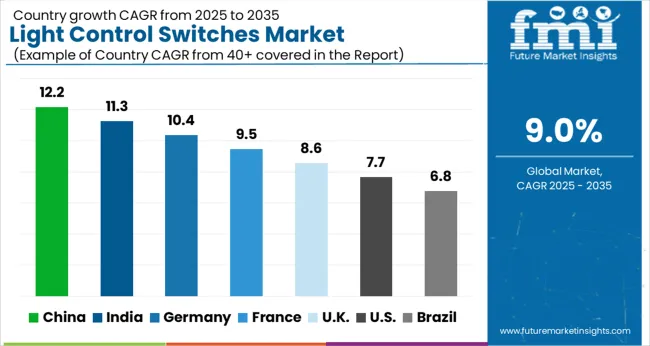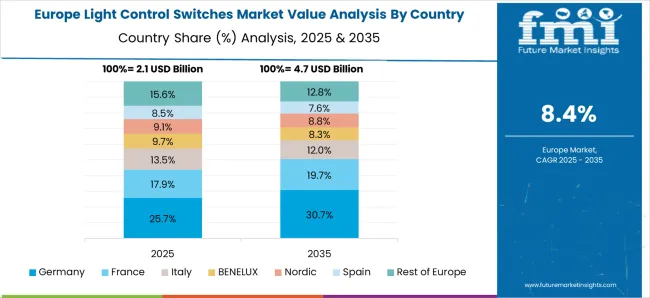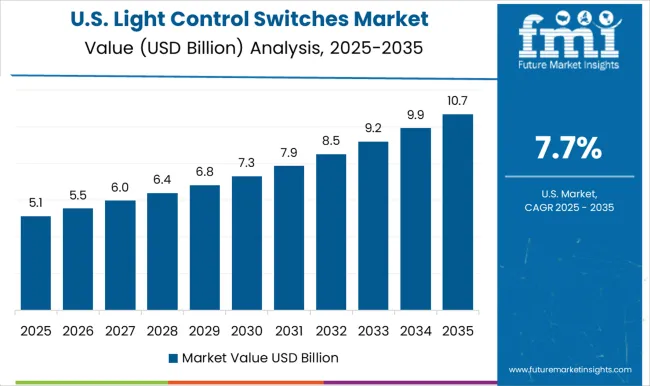The Light Control Switches Market is estimated to be valued at USD 9.3 billion in 2025 and is projected to reach USD 21.9 billion by 2035, registering a compound annual growth rate (CAGR) of 9.0% over the forecast period. The absolute dollar opportunity analysis highlights significant growth throughout the forecast period, driven by the increasing adoption of smart home technologies, energy-efficient lighting solutions, and automation systems. Between 2025 and 2030, the market expands from USD 9.3 billion to USD 14.3 billion, contributing USD 5 billion in growth. This early-phase expansion is fueled by rising demand for integrated lighting control solutions in residential, commercial, and industrial sectors.
The increasing preference for smart homes, connected devices, and energy-saving solutions contributes to the growth, with a significant emphasis on ease of control, convenience, and sustainability. From 2030 to 2035, the market continues to grow from USD 14.3 billion to USD 21.9 billion, adding USD 7.6 billion in growth. This phase is characterized by the growing penetration of smart city initiatives and the widespread adoption of wireless and advanced light control systems that offer enhanced features such as automation, remote control, and energy monitoring. The absolute dollar opportunity reveals strong and consistent market expansion, driven by technological advancements and increasing consumer demand for smart, energy-efficient lighting solutions. The growth is further supported by rising awareness of energy conservation and government initiatives promoting the adoption of energy-efficient products.
| Metric | Value |
|---|---|
| Light Control Switches Market Estimated Value in (2025 E) | USD 9.3 billion |
| Light Control Switches Market Forecast Value in (2035 F) | USD 21.9 billion |
| Forecast CAGR (2025 to 2035) | 9.0% |
Government initiatives promoting energy conservation and building automation standards are encouraging widespread integration of intelligent lighting control. Advancements in digital lighting architecture, coupled with rising awareness around cost savings and carbon footprint reduction, are accelerating product adoption across both residential and commercial sectors. Manufacturers are focusing on innovation in sensor based and programmable switches to meet evolving user preferences for comfort and control.
With increased connectivity and urban development, the market outlook remains optimistic as lighting control systems are positioned as essential components in smart building ecosystems and energy management strategies.
The light control switches market is segmented by product type, solution type, communication technology, light source, application, and geographic regions. By product type, the light control switches market is divided into Switches and dimmers. The light control switches market is classified into two solution types: Standalone light control solutions and Integrated light control solutions.
Based on communication technology, the light control switches market is segmented into Wired technology and Wireless technology. By light source, the light control switches market is segmented into Incandescent, Fluorescent, High-intensity discharge, light-emitting diode, and Compact Fluorescent Lamp (CFL). By application, the light control switches market is segmented into Residential, Commercial, Industrial, Highways & roadways lighting, Architectural lighting, and Lighting for public places. Regionally, the light control switches industry is classified into North America, Latin America, Western Europe, Eastern Europe, Balkan & Baltic Countries, Russia & Belarus, Central Asia, East Asia, South Asia & Pacific, and the Middle East & Africa.
The switches segment is anticipated to contribute 48.30% of total revenue by 2025 within the product type category, establishing it as the dominant offering. This is primarily due to its widespread use in both legacy and modern lighting infrastructures, providing ease of operation and affordability.
Traditional wall mounted switches continue to serve as the foundational control mechanism in many residential and commercial installations. The introduction of programmable and sensor based switches has further enhanced their value, allowing users to adjust lighting based on occupancy, time, or ambient conditions.
Their straightforward integration and user familiarity have reinforced their position as the preferred choice for efficient lighting control, especially in retrofit projects and basic automation setups.
Standalone light control solutions are projected to account for 53.60% of overall revenue by 2025 within the solution type category, making it the leading segment. This growth is driven by the simplicity, cost efficiency, and installation flexibility of standalone systems, which do not require centralized control infrastructure.
These solutions are favored in small to mid scale commercial buildings, residential complexes, and retrofit applications where quick deployment and independent room based control are priorities. Enhanced product availability and compatibility with a variety of lighting fixtures have contributed to their market dominance.
Additionally, they align well with the needs of energy conscious users seeking modular and scalable solutions without significant upfront investment in full automation systems.
Wired technology is expected to represent 44.90% of the total revenue share by 2025 under the communication technology category, maintaining its position as the preferred connectivity mode. This dominance is attributed to the reliability, speed, and low latency performance that wired systems offer in lighting control environments.
Common in large commercial buildings and industrial applications, wired networks provide stable communication unaffected by wireless interference or signal dropouts. The long term cost benefits and robust performance of wired setups make them ideal for critical infrastructure and high traffic zones.
As facility managers prioritize consistency and long term value, the preference for wired communication continues to solidify its role as the standard in professional lighting control applications.
The light control switches market is growing due to the increasing demand for energy-efficient and smart lighting solutions. These switches allow users to control light intensity, color, and timing, offering improved energy savings and enhanced user convenience. As consumers and businesses prioritize automation and energy management, smart and advanced light control switches are becoming integral in both residential and commercial settings. The rise in smart homes, along with the growing adoption of IoT-based devices, is further driving the demand for innovative and customizable light control systems.
The light control switches market is growing due to the increasing need for energy-efficient lighting solutions and the rising popularity of smart homes and buildings. Light control switches enable users to reduce energy consumption by adjusting lighting levels based on factors like time of day, occupancy, and ambient light conditions. This energy-saving capability makes them highly attractive in a world focused on sustainability. With the integration of IoT technologies, these systems can be controlled remotely via smartphones and voice assistants, improving user convenience and control. Smart light control systems also offer enhanced features, such as automated scheduling and energy monitoring, which contribute to reduced electricity bills and better energy management, driving the growth of the market.
Despite the market's expansion, the light control switches market faces several challenges. A significant hurdle is the high initial cost of advanced light control switches, especially those with smart features, which can be a barrier for price-sensitive consumers. Traditional switches remain a more affordable option, potentially limiting the adoption of advanced systems. In addition, the installation process for smart light control switches can be complex, requiring specialized wiring, integration with other smart home systems, or professional assistance. These added installation costs and the need for technical expertise may deter some potential buyers, particularly in residential markets where budget constraints are more common. Simplifying the installation process and reducing the upfront cost will be crucial to increasing market penetration.
The light control switches market offers significant opportunities, particularly with innovations in smart lighting and automation technologies. Manufacturers are integrating advanced features like motion sensing, voice control, and remote management, allowing users to personalize their lighting experience and further improve energy efficiency. The development of advanced sensors and controls also enables the creation of intelligent lighting systems that adjust automatically based on environmental changes. The growing demand for smart home integration, where lighting systems can be seamlessly linked to other household systems like security, climate control, and entertainment, provides a large growth opportunity. As the need for connected, automated homes and buildings rises, smart light control switches are expected to see increased adoption, contributing to the market’s expansion.
One of the most significant trends in the light control switches market is the integration of these systems with IoT and smart home networks. Consumers are increasingly seeking lighting solutions that provide convenience and control via smartphones or voice assistants, offering a higher level of flexibility. IoT-enabled light control switches allow seamless integration with other smart devices, such as thermostats, security cameras, and door locks, creating a connected home ecosystem. This growing demand for interconnected systems is driving innovation in light control switches, as consumers expect more functionality and greater control over their home environments. As smart home technologies continue to evolve, the light control switches market is poised for rapid growth, offering smarter, more energy-efficient solutions to consumers.

| Country | CAGR |
|---|---|
| China | 12.2% |
| India | 11.3% |
| Germany | 10.4% |
| France | 9.5% |
| UK | 8.6% |
| USA | 7.7% |
| Brazil | 6.8% |
The global light control switches market is projected to grow at a CAGR of 6.8% from 2025 to 2035. Of the five profiled markets out of 40 covered, China leads at 12.2%, followed by India at 11.3%, and France at 9.5%, while the United Kingdom records 6.5% and the United States posts 5.8%. These rates translate to a growth premium of +35% for China, +25% for India, and +5% for France versus the baseline, while the United States and the United Kingdom show slower growth. Divergence reflects local catalysts: increasing demand for energy-efficient lighting solutions, smart home technologies, and automation in China and India, while more mature markets like the United States and the United Kingdom experience more moderate growth due to established infrastructure. The analysis includes over 40+ countries, with the leading markets detailed below.
The light control switches market in China is growing at a 12.2% CAGR through 2035. The rapid expansion of urban infrastructure and commercial sectors in China is driving the demand for smart home technologies and energy-efficient solutions. The growing adoption of connected lighting systems, especially in residential and commercial buildings, is a key growth factor. The government’s push for modernization of energy grids and the rise of sustainable building projects further accelerates the demand for advanced light control systems in China. With a large market for both residential and industrial sectors, China continues to drive growth in the global market.
The light control switches market in India is projected to grow at an 11.3% CAGR through 2035. The increasing adoption of smart homes, particularly in urban centers, is a major contributor to this growth. The demand for energy-efficient lighting solutions in residential, commercial, and industrial buildings is rising as India focuses on improving energy access and efficiency. Government schemes promoting energy-efficient building construction and the expanding middle-class population contribute significantly to market expansion. Additionally, the growing preference for connected homes and office environments boosts the adoption of light control switches in India.

The light control switches market in France is expanding at a 9.5% CAGR through 2035. The demand for energy-efficient solutions, particularly in residential and commercial buildings, is a key driver of market growth. France’s strong focus on sustainability and green building certifications has led to an increased adoption of energy-saving technologies, including light control switches. The growing demand for automation and smart home technologies in urban centers, coupled with the country’s emphasis on reducing carbon footprints, supports the expansion of the light control switches market.
The UK market for light control switches is expected to grow at a 8.6% CAGR through 2035. The country’s ongoing efforts to improve energy efficiency and reduce carbon emissions have led to increased demand for smart lighting solutions. As the UK invests in more energy-efficient infrastructure, particularly in commercial and residential sectors, the adoption of advanced light control systems continues to rise. The country’s focus on sustainable construction and smart building technologies is driving market growth, particularly in urban areas where energy-saving solutions are becoming increasingly important.

The USA light control switches market is projected to grow at a 7.7% CAGR through 2035. The USA market is driven by increasing demand for smart home technologies and energy-efficient lighting solutions. The rise in home automation and IoT-based lighting systems is contributing significantly to market expansion. The growing focus on reducing energy consumption and the adoption of smart grid technologies in both residential and commercial buildings further accelerates the market for light control switches. Government incentives and energy efficiency programs continue to promote the adoption of advanced lighting solutions across the USA
Legrand is a leading player, providing advanced light control switches known for their reliability and smart functionalities, catering to both residential and commercial applications. Schneider Electric specializes in energy-efficient and intelligent lighting solutions, offering integrated light control switches that help optimize energy consumption and improve automation. Lutron Electronics Co., Inc. is a key player in the market, known for its high-quality dimmer switches and smart lighting control systems. Their solutions are widely used in residential, commercial, and hospitality sectors, offering energy savings and enhanced comfort. Signify Holding (formerly Philips Lighting) provides light control systems that combine energy efficiency with smart technologies, catering to the growing demand for smart home integration and lighting automation. OSRAM, a leader in lighting technology, offers light control switches that emphasize performance and energy savings for both residential and commercial uses. Panasonic Corporation provides a wide range of light control solutions with a focus on convenience, energy efficiency, and smart home integration. Hubbell offers light control systems that focus on safety, reliability, and energy management for industrial, commercial, and residential applications. These companies differentiate themselves by offering innovative, energy-efficient, and user-friendly light control solutions, with a growing emphasis on smart technology integration, energy savings, and automation to meet the demands of modern lighting systems.
| Item | Value |
|---|---|
| Quantitative Units | USD 9.3 Billion |
| Product Type | Switches and Dimmer |
| Solution Type | Standalone light control solutions and Integrated light control solutions |
| Communication Technology | Wired technology and Wireless technology |
| Light Source | Incandescent, Fluorescent, High-intensity discharge, Light emitting diode, and Compact Fluorescent Lamp (CFL) |
| Application | Residential, Commercial, Industrial, Highways & roadways lighting, Architectural lighting, and Lighting for public places |
| Regions Covered | North America, Europe, Asia-Pacific, Latin America, Middle East & Africa |
| Country Covered | United States, Canada, Germany, France, United Kingdom, China, Japan, India, Brazil, South Africa |
| Key Companies Profiled | Legrand, Schneider Electric, Lutron Electronics Co., Inc., Signify Holding, OSRAM, Panasonic Corporation, and Hubbell |
| Additional Attributes | Dollar sales by product type (dimmers, motion sensors, timers, smart switches) and end-use segments (residential, commercial, industrial). Demand dynamics are driven by increasing adoption of smart lighting, energy-efficient systems, and automation technologies. Regional trends show strong growth in North America, Europe, and Asia-Pacific, with technological advancements in smart lighting and increasing demand for energy-saving solutions contributing to market expansion. |
The global light control switches market is estimated to be valued at USD 9.3 billion in 2025.
The market size for the light control switches market is projected to reach USD 21.9 billion by 2035.
The light control switches market is expected to grow at a 9.0% CAGR between 2025 and 2035.
The key product types in light control switches market are switches and dimmer.
In terms of solution type, standalone light control solutions segment to command 53.6% share in the light control switches market in 2025.






Full Research Suite comprises of:
Market outlook & trends analysis
Interviews & case studies
Strategic recommendations
Vendor profiles & capabilities analysis
5-year forecasts
8 regions and 60+ country-level data splits
Market segment data splits
12 months of continuous data updates
DELIVERED AS:
PDF EXCEL ONLINE
Lightening and Whitening Creams Market Analysis - Size and Share Forecast Outlook 2025 to 2035
Lightweight Automotive Body Panels Market Size and Share Forecast Outlook 2025 to 2035
Lightening / Whitening Agents Market Size and Share Forecast Outlook 2025 to 2035
Lightweight Handheld Cordless Vacuum Cleaner Market Size and Share Forecast Outlook 2025 to 2035
Light Setting Spray Market Size and Share Forecast Outlook 2025 to 2035
Light-Activated Anti-Pollution Skincare Market Analysis - Size and Share Forecast Outlook 2025 to 2035
Lighting As A Service Market Size and Share Forecast Outlook 2025 to 2035
Light Duty Truck Market Size and Share Forecast Outlook 2025 to 2035
Light Commercial Vehicle Market Size and Share Forecast Outlook 2025 to 2035
Light Emitting Diode (LED) Backlight Display Market Size and Share Forecast Outlook 2025 to 2035
Lighting as a Service (LaaS) Market Size and Share Forecast Outlook 2025 to 2035
Light Field Market Size and Share Forecast Outlook 2025 to 2035
Lighting Product Market Size and Share Forecast Outlook 2025 to 2035
Light Field Cameras Market Size and Share Forecast Outlook 2025 to 2035
Light Resistant Containers Market Size and Share Forecast Outlook 2025 to 2035
Lightweight Acoustic Floor Systems Market Size and Share Forecast Outlook 2025 to 2035
Lightweight Food Container Market Size and Share Forecast Outlook 2025 to 2035
Light Density Polyethylene (LDPE) Bottles Market Growth Trends Forecast 2025 to 2035
Light-Changing Packaging Inks Market - Growth & Demand 2025 to 2035
Light Fidelity (Li-Fi) Market Growth – Trends & Forecast 2025 to 2035

Thank you!
You will receive an email from our Business Development Manager. Please be sure to check your SPAM/JUNK folder too.
Chat With
MaRIA